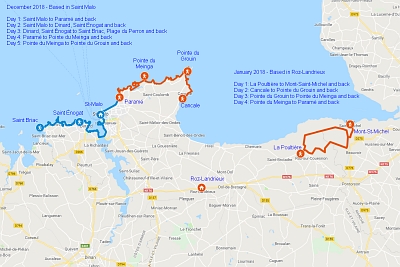GR34: The North
(vero;2019-March-30)
We have two galleries so far:
- The first one includes pictures taken during two one-week stays in the north of Brittany, the first one based in Roz-Landrieux not far from the Mont Saint Michel (one of our favourite places in France) and the second one based in Saint-Malo. All the pictures have been taken in winter in the months of December or January. They are proof that the weather can be very nice in this season with the added bonus of hardly a soul around. Of course, we had also cloudy and rainy skies but those are the days when we take the time to visit towns and the hinterland. Brittany in winter? Highly recommended!
- Since we are often in the Cité Corsaire of Saint-Malo and its neighbours Saint-Servan and Dinard, we have started below a second gallery for these places, with more pictures to be added as time will pass.
Some pictures taken during two one-week stays in the north of Brittany
The Cité Corsaire of Saint-Malo and its neighbours Saint-Servan and Dinard
Go back to Along Brittany's Coastal Path or go on to GR34: The West or go up to Landscapes
$updated from: Along Brittany's Coastal Path.htxt Mon 04 Mar 2024 16:04:47 trvl2 (By Vero and Thomas Lauer)$
















































